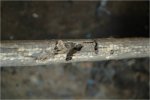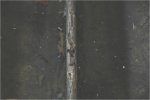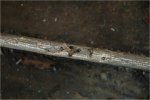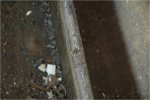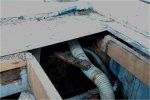petermarcus
Petty Officer 2nd Class
- Joined
- Apr 30, 2010
- Messages
- 132
Re: Newby Rebuild, Ambitious or insane?
I did a bit of research, and I found (of course), a lot of conflicting information.
The US does a Hull Identification Number that's 12 digits, Europe (and the rest of the world) does a CIN (Craft ID Number) that's 14 digits, including a 2-letter country code. After the country code, the first three are supposed to be a manufacturer ID. In your case, that would be MLI.
Here's one site, a US based HIN decoder: http://www.uscgboating.org/recalls/mic1.aspx
It says MLI is Newmax, Inc, out of Spokane, Washington. What I could find through a Google search seems to say that Newmax mainly made pontoon boats. I could be wrong about that, but that's all I could find.
The Manufacturer ID can also be an Importer ID, if a company imports a hull or boat, then makes changes to it. As far as importers go, MLI stands for M.L. Importers, Inc, out of Gloucester, Massachusetts, which is now inconveniently out of business. I couldn't find anything about them other than their location.
What's troubling about the HIN/CIN issue is that the last 4 digits is supposed to be Month/Year of manufacture, -- 1272 would be December 1972. Or, things eventually moved to a letter/year like M76D which stands for "M"odel year 1976, and D for November (oddly). Your last 4 are 728B. B would mean September, so it's possible that 728B is September 1972 (maybe September 8th?) except that it (1) breaks the normal format, and (2) the laws/guidelines about HIN/CIN didn't really kick in until November of 1972 anyway.
That JP number -- was it on the transom, or inside the boat? The HIN guidelines say it should be on the starboard side of the transom, but then again, your boat may older than the guidelines. The guidelines also say the HIN should be in another location inside your boat, but that location is a secret and is usually only given to law enforcement if they're trying to trace a stolen boat. Something like under a seat or on the inside of the cap under the anchor locker.
About your stringer question:
The idea of stringers, especially with an I/O, is that the thrust from the prop and outdrive press mainly against the transom of your boat (there's some distribution through the bell housing to the engine to the engine mounts, but it's mainly through the transom). The transom absorbs all of that thrust balanced against the weight of your boat, and the friction of the water. The transom alone can't support those forces, so the whole concept of stringers is that they are butted against the transom and bonded to the hull so the thrust forces are spread out through the bottom of the hull. If you tipped your boat up so it's resting on the transom, it's similar to a house. The transom is the foundation and the stringers are the load bearing walls.
So, there's no theoretical problem with hollow stringers if that hollowness is supported by something load-bearing, like a thick, strong fiberglass -- similar to commercial structures where the 2x4 studs might actually be aluminum, but in an I-beam kinda shape where the forces are reinforced. If enough quality fiberglass surrounds cotton-candy as a support until the fiberglass sets, that should be fine. In reality, many stringers are something structural like plywood or fir or oak, with the glass as additional (or primary) support, but also a (hopefully) waterproofing agent to keep the core solid. And, if that inner core material catches a fungus and rots, then it's going to sound hollow and you may wonder if it was designed to be hollow, or if it became that way. If you drill into it and get rotten wood, then you know, and welcome to the club!
Finally, I'm really interested in this project. I like the bigger boats -- I'm only restoring a 19' because that's what happened to have fallen in my lap for virtually nothing. I'd love a crack at your 25 footer. Also, you have an interesting puzzle and you're in an interesting location. I'm really looking forward to you digging into your project and documenting it for the rest of us. Take a lot of pics and keep posting!
I did a bit of research, and I found (of course), a lot of conflicting information.
The US does a Hull Identification Number that's 12 digits, Europe (and the rest of the world) does a CIN (Craft ID Number) that's 14 digits, including a 2-letter country code. After the country code, the first three are supposed to be a manufacturer ID. In your case, that would be MLI.
Here's one site, a US based HIN decoder: http://www.uscgboating.org/recalls/mic1.aspx
It says MLI is Newmax, Inc, out of Spokane, Washington. What I could find through a Google search seems to say that Newmax mainly made pontoon boats. I could be wrong about that, but that's all I could find.
The Manufacturer ID can also be an Importer ID, if a company imports a hull or boat, then makes changes to it. As far as importers go, MLI stands for M.L. Importers, Inc, out of Gloucester, Massachusetts, which is now inconveniently out of business. I couldn't find anything about them other than their location.
What's troubling about the HIN/CIN issue is that the last 4 digits is supposed to be Month/Year of manufacture, -- 1272 would be December 1972. Or, things eventually moved to a letter/year like M76D which stands for "M"odel year 1976, and D for November (oddly). Your last 4 are 728B. B would mean September, so it's possible that 728B is September 1972 (maybe September 8th?) except that it (1) breaks the normal format, and (2) the laws/guidelines about HIN/CIN didn't really kick in until November of 1972 anyway.
That JP number -- was it on the transom, or inside the boat? The HIN guidelines say it should be on the starboard side of the transom, but then again, your boat may older than the guidelines. The guidelines also say the HIN should be in another location inside your boat, but that location is a secret and is usually only given to law enforcement if they're trying to trace a stolen boat. Something like under a seat or on the inside of the cap under the anchor locker.
About your stringer question:
The idea of stringers, especially with an I/O, is that the thrust from the prop and outdrive press mainly against the transom of your boat (there's some distribution through the bell housing to the engine to the engine mounts, but it's mainly through the transom). The transom absorbs all of that thrust balanced against the weight of your boat, and the friction of the water. The transom alone can't support those forces, so the whole concept of stringers is that they are butted against the transom and bonded to the hull so the thrust forces are spread out through the bottom of the hull. If you tipped your boat up so it's resting on the transom, it's similar to a house. The transom is the foundation and the stringers are the load bearing walls.
So, there's no theoretical problem with hollow stringers if that hollowness is supported by something load-bearing, like a thick, strong fiberglass -- similar to commercial structures where the 2x4 studs might actually be aluminum, but in an I-beam kinda shape where the forces are reinforced. If enough quality fiberglass surrounds cotton-candy as a support until the fiberglass sets, that should be fine. In reality, many stringers are something structural like plywood or fir or oak, with the glass as additional (or primary) support, but also a (hopefully) waterproofing agent to keep the core solid. And, if that inner core material catches a fungus and rots, then it's going to sound hollow and you may wonder if it was designed to be hollow, or if it became that way. If you drill into it and get rotten wood, then you know, and welcome to the club!
Finally, I'm really interested in this project. I like the bigger boats -- I'm only restoring a 19' because that's what happened to have fallen in my lap for virtually nothing. I'd love a crack at your 25 footer. Also, you have an interesting puzzle and you're in an interesting location. I'm really looking forward to you digging into your project and documenting it for the rest of us. Take a lot of pics and keep posting!





















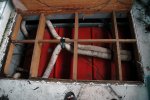
![IMG_0771[1].jpg](/data/attachments/57/57283-b7b24fd761df2aefc5a68970faed7b32.jpg)
![IMG_0772[1].jpg](/data/attachments/57/57285-0ebc1193c56ba9b75600781c27ec898a.jpg)
![IMG_0773[1].jpg](/data/attachments/57/57286-2a3fe36f2f7ec15649cc55e198b3615a.jpg)
